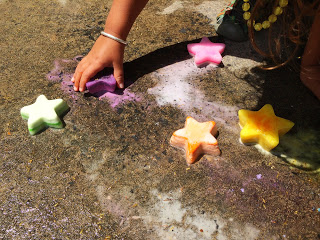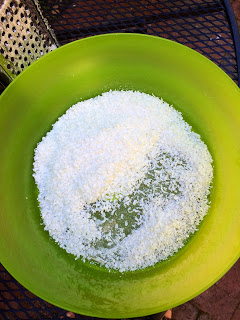I was so excited when I saw some “candy corn candles” online the other day, I couldn’t wait to make them! The candles were so cute, but when I read the tutorial, I discovered that they were just white candles painted to look like candy corn! What a disappointment! I figured, “How hard could it be to actually make CANDY CORN CANDLES?” And so I did just that! I’ve made all types of candles before and each time is an experiment. They are a lot of fun to play around with! Give yourself some time and patience when you’re making candles…they are definitely worth it! These candy corn candles may be my favorite yet! They’re seasonal and adorable! My suggestion is to make a few at a time…one for you to keep and a couple to give away as gifts!

Materials needed:
- large pot with 1-2 in. water inside
- metal pouring-pot or large metal can
- paraffin wax
- crayons (yellow, orange and white)
- mason jars
- primed wicks
- pencils
- paper towels
- wax paper (to protect your counter top)
- wooden skewer or stick
- candle thermometer

First, place your metal pouring pot (or large can) into the large pot of water. Place 2-3 blocks of paraffin wax into the pouring pot. Turn the stove on high, bringing the water to a boil, then turn it down a bit so the water doesn’t boil over.

As your wax melts, peel the paper off of two orange crayons. The easiest way to do this is to carefully slice the paper down the side with a sharp knife.

If you have a candle thermometer, continue to heat the wax until it reaches 180 degrees. Usually once all the wax is melted it is at or near 180 degrees. Now, add the two orange crayons. Using a wooden skewer or a stick, mix the color and wax together.


Carefully pour the orange wax into your three mason jars. If you have any excess wax, you can pour it into a disposable bread pan and save the wax for later. (I poured mine into a cheap coffee mug and made an additional candle in a mug!)

The next step is a little tricky, but take your time…wax doesn’t harden immediately, so relax and stay calm! Place your candle wick into the middle of the candle and wrap the extended portion around a pencil. Lay the pencil across the jar to keep the wick in place. You may have to move the pencil around a bit to get the wick right where you want it. Sometimes the wick likes to move within the first few minutes, so keep an eye on it!

Let the wax set for at least 30 min to an hour, but not much more. While you’re waiting, reheat the few drops of wax that remain in the pouring pot and, careful not to burn yourself, wipe the pot out with a paper towel.
After the wax has set, it’s time to do the exact same thing, but this time making yellow candle wax! Heat the paraffin wax in the pouring pot or large can. After it melts, throw in two yellow crayons. Mix the wax with the other end of your wooden skewer. Carefully pour the wax into your three jars. Let it set 30 min to an hour and wipe out your pouring pot.

And last, but not least…time to do the same with the white wax. If your paraffin is semi-translucent before it melts, I’d add a white crayon or two. Some paraffin wax that is designed specifically for candle-making is very white to begin with…you don’t have to add any crayons to this type.

Now, let your candles set for a few hours! Sometimes when making candles a little well develops around the wick as it sets. If this happens, melt some more white wax and carefully pour it into the well to top it off. For the first time in making candles myself, this didn’t happen with my candy corn candles! Once set, the tops were just as flat as when I poured the wax in. Trim the wicks down to about half an inch. Enjoy!!!

Some tips I learned the hard way:
- You definitely need at least 2 crayons to color the wax. When the wax sets, the color will appear much lighter than it looks when poured. If the orange color appears too light for your taste, you can carefully place the jar into hot or boiling water to re-melt the wax and stir in another crayon piece. Best to avoid this step altogether though, and put enough color in at the start!
- When making these layered, candy corn candles, let the wax set for an hour in-between pouring layers, but not much more! When I made these, I poured the orange and yellow wax at night and then I waited til morning to add the final, white layer. I totally forgot that the wax can shrink a bit when it completely sets, causing it to separate from the jar a little. When I went to pour the white wax onto the top, in two of my candles the white wax seeped down the edges, covering up the yellow a little bit. Oops! So let the wax set, but not for over an hour before adding the next layer!

Enjoy this adorable craft! They are just too cute!




























































































































































